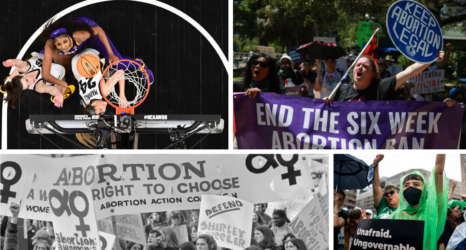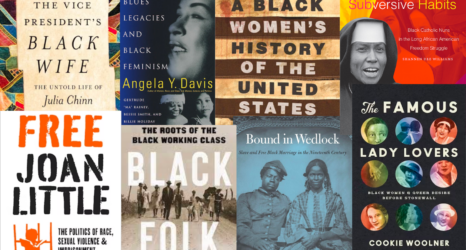In the rest of the city, people are trudging through the rain and struggling to keep their umbrellas from flipping inside out. But inside Chicago’s Good Shepherd Lutheran Church, it’s warm and bright. A small choir and a guitarist are warming up, the sound of their hymn barely filling the open space of the nave. Soon they’ll have the voices of the congregation to bolster them.
Most of the guests have arrived at least half an hour early for the ordination ceremony. Weaving through the family and friends of the ordination candidate, a group of middle-aged women chat with each other, greet guests and help set up. They’re not hand-shakers, they’re huggers, and everyone they say hello to gets pulled in. These are the Roman Catholic Womenpriests (RCWP), a group of women who, in defiance of Roman Catholic Church law, have become priests. They have come from across the country for this ordination ceremony, a chance to put another woman on the path to priesthood by ordaining her a deacon.
The crowd falls silent, and the pews creak as everyone stands. The ceremony begins as womenpriests in white process down the central aisle, singing:
We come to share our story. We come to break the bread. We come to know our rising from the dead.
In two hours, Kathy Rolenc will be a deacon.
Rolenc has been dreaming of her ordination for years. She remembers the moment when her calling first struck her. As she watched her priest consecrate the Eucharist, the wafer of bread that Catholics believe becomes the literal body of Christ, by lifting it up and proclaiming, “This is my body,” she knew that she wanted to be up there someday, saying those exact words.
It wasn’t until Rolenc asked to be an altar server that her mother had to tell her the truth: Girls weren’t allowed to serve on the altar, and they certainly weren’t allowed to be priests.
The church has been closed to female priests since its inception 2,000 years ago, resting on “apostolic succession,” the idea that Jesus created the priesthood for his 12 disciples during the Last Supper and that those who direct the church today are part of a line of leadership that stretches back to the original 12.
But the gospels aren’t history books. “There were basically women who were silenced in the early church. The tradition has been that the priesthood was reserved exclusively for males,” says Dr. Susan Ross, a theology professor at Loyola University Chicago who studies feminist theology. Womenpriests are building a community from the ground up, dealing with the threat of excommunication as they search for space in a church that tells them their callings are impossible. It’s right there in canon law: “A baptized male alone receives sacred ordination validly.”
To be legitimate, womenpriests needed to join this spiritual family tree. This fact concerned RCWP Bishop Joan Houk until she heard about a man, a bishop in good standing with the Catholic Church, who had ordained several women. “The reason I was able to be ordained is because I know I have not taken myself out of the church,” says Houk, who spent many years deliberating before deciding to follow her calling. This man, known as Bishop X, gave the womenpriests legitimacy, despite the threat of excommunication.
In order to protect him, the womenpriests won’t reveal Bishop X’s name until after his death or after the church accepts female leadership, whichever comes first. On some days, the former seems more likely than the latter. “It was my intention to wait until the leadership of the church would call forth women and ordain them. And I was convinced it was going to happen by the time I was 80, and I’m going to be 75 [soon]. They’ve got five more years to get it right,” Houk jokes.
There has been some progress. Since his election to the papacy in 2013, Pope Francis has been called a leader for a new, more liberal church, even calling for equal pay for women. Yet for the womenpriests and their political supporters, progress still seems slow.
According to Georgetown’s Center for Applied Research in the Apostolate, there are over 20,000 fewer priests in America today than there were in the 1960s. Multiple surveys have shown that women are more likely than men to attend church regularly, and more likely to consider religion an important part of their lives. Yet even Pope Francis, with his relatively liberal stances on many issues, has rejected ordination for women. “[O]n women priests, that cannot be done,” he said, on his way home after his September 2015 tour of the U.S. “Pope St. John Paul II after long, long intense discussions, long reflection said so clearly.”
But with a well-publicized and ongoing sexual abuse scandal, what many see as a backwards stance on LGBT rights, and a rapidly aging clergy, the church needs a makeover. Ordaining women could be the solution.
Kate McElwee works from Rome as the executive director for international affairs for the Women’s Ordination Conference (WOC), one of several groups—including the U.K.’s Catholic Women’s Ordination, the RCWP and the Association of Roman Catholic Womenpriest—that advocates for women in the priesthood. She’s frustrated by what she sees as a lack of progress, notably the fact that women are excluded from committees that don’t even require participants to be ordained. She pointed to a recent synod—a meeting of church leaders—focused on the family. The majority of the attendees were ordained men—who, by virtue of canonical law, do not marry or have children after being ordained.
“I feel like part of my role in Rome is to make it embarrassing to have a meeting about women without women in the room,” McElwee says. According to Vatican Radio, only 18 percent of staffers at the Vatican are women, although that number is on the rise.
“I’m thinking it’s less important that [change] come from the pope. I’m at peace with Francis being who he is,” says Margaret Johnson, WOC’s secretary. “The movement doesn’t rest on whether or not he’s got it right. There’s still an invitation for him to get it right.”
For some women, the wait for change has been long enough. In 2002, the first seven womenpriests pledged themselves to God during a ceremony in Germany on the banks of the Danube River. The next year, three women, including two of those who had been ordained on the Danube, became bishops. Currently, there are over 145 womenpriests across the world, all of whom were ordained only after a lengthy training process.
Before she found the Roman Catholic Womenpriests in 2007, Kathy Rolenc worked with the Catholic Church as a youth leader. Prior to that, she threw herself into life as a tomboy, dreaming as a child that she could change genders and enter the priesthood. Rolenc talks like she’s telling you a story in a bar, but instead of spinning a tale about the largest fish she ever caught, she’s talking about the grace of God. Even a week before the ceremony, her excitement was obvious. “I’ve been ready for years,” she says with a laugh. “I’m a giddy schoolgirl. I haven’t been sleeping because it’s all I think about.”
As part of her training, Rolenc and her mentor, Rev. Barbara Zeman, say mass for a group of around five people during off hours in a Lutheran church on the Westside of Chicago. There, they forgo the altar and instead conduct mass around a small table placed at the front of the church. Zeman, who has only been a priest since 2009, remembers how she struggled to find guidance and mentorship. “We’re really out there on the edge,” she says of the womenpriests. “We’re really out there on a tightrope, and when I looked for a mentor I found my mentor in the Lutheran Church because I didn’t have any male counterparts that would be willing to be with me.”
By choosing to break what they see as an unjust law, these women often lose the support of their religious communities.
“I remember people telling me that I’m going to hell,” says Rolenc. “You hear that often, that it’s not a genuine call, it’s the devil. You do start questioning yourself. But I learned that’s where the devil comes into play.” While she’s suffered from self-doubt, Rolenc truly feels she is obeying God. “I remember actually telling God he could take the calling and shove it right up his ass,” she says. “But you calm down, you settle yourself in, you hear that one clear voice and it comes back to you again. God doesn’t give up.”
“This obstacle is an obstacle of culture, of tradition, of church,” says Zeman. “It’s that kind of an obstacle that really causes you to say, ‘OK, I’m jumping off the cliff here. And as I jump off this cliff, I’m asking you, God, to help me because I know you have called me.’”
In the face of those obstacles, not every womanpriest can afford to be as bold as Zeman, who isn’t affiliated with the mainstream Catholic Church. Unlike Zeman, women who have been ordained as womenpriests or deacons but can’t speak out for fear of retribution—losing their jobs with the church, facing discrimination in their mainstream Catholic communities—are called “catacombs” by the rest of the womenpriests, an allusion to early Christians who held mass in secret in the catacombs of Rome.
Working as a youth leader and keeping her calling silent was an isolating experience for Rolenc. It wasn’t until she was invited to play drums at Zeman’s ordination that she saw the potential for community. “It was the first time I’d seen women on the altar like that. Feeling accepted—that was the biggest part. Being around women who were aliens like myself, that was the best feeling.”
At the end of the ordination service, Houk and the Lutheran minister of Good Shepherd hold the new deacon’s arms in the air as she faces the congregation. Rolenc, with her curly hair and quick grin, looks like a wrestling champion on stage, arms held up by the refs who have watched her battle it out and win. Behind her are banners that depict famous women in the church, including St. Thérèse of Lisieux, the “little flower” who wrote, “If I were a priest, oh Jesus, with what love I would give you to people.” In this moment, Rolenc is joining two lines of succession, the spiritual family trees of both Bishop X and the women of the Catholic Church.
Zeman sums it up: “We stand on Susan B. Anthony’s shoulders. We stand on Gloria Steinem’s shoulders. We stand on the nuns’ shoulders.” Now, Rolenc stands on the shoulders of women like Zeman and Houk, who have come before her.
“Standing up there,” she says, “I knew I was in the right place, and I knew I was doing the right thing.”
Get the Ms. Blog in your inbox! Click here to sign up for our newsletter.
Photos courtesy of the author. Opening photo of the newly ordained Deacon Rolenc.





